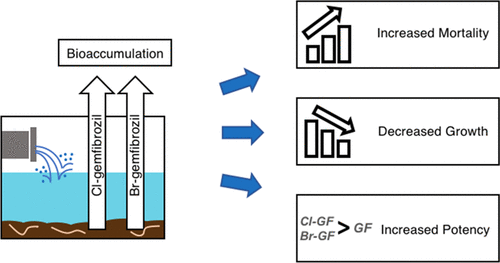当前位置:
X-MOL 学术
›
Environ. Sci. Technol.
›
论文详情
Our official English website, www.x-mol.net, welcomes your
feedback! (Note: you will need to create a separate account there.)
Novel Disinfection Byproducts Formed from the Pharmaceutical Gemfibrozil Are Bioaccumulative and Elicit Increased Toxicity Relative to the Parent Compound in Marine Polychaetes (Neanthes arenaceodentata).
Environmental Science & Technology ( IF 10.8 ) Pub Date : 2020-08-14 , DOI: 10.1021/acs.est.0c01080 Nicolette E Andrzejczyk 1 , Justin B Greer 1 , Eric Nelson 2 , Junqian Zhang 3 , John M Rimoldi 4 , Rama S V Gadepalli 4 , Isaiah Edwards 4 , Daniel Schlenk 1
Environmental Science & Technology ( IF 10.8 ) Pub Date : 2020-08-14 , DOI: 10.1021/acs.est.0c01080 Nicolette E Andrzejczyk 1 , Justin B Greer 1 , Eric Nelson 2 , Junqian Zhang 3 , John M Rimoldi 4 , Rama S V Gadepalli 4 , Isaiah Edwards 4 , Daniel Schlenk 1
Affiliation

|
Formation of halogenated disinfection byproducts (DBPs) from pharmaceutically active compounds has been observed in water supply systems following wastewater chlorination. Although research has been limited thus far, several studies have shown that halogenated DBPs may elicit increased toxicity compared to their parent compounds. For example, the lipid regulator gemfibrozil has been shown to form chlorogemfibrozil (Cl-gemfibrozil) and bromogemfibrozil (Br-gemfibrozil) following chlorination, which are more potent antiandrogens in male Japanese medaka (Oryzias latipes) compared to their parent compounds. In the present study, we aimed to characterize the bioaccumulative ability of halogenated gemfibrozil DBPs in marine polychaetes via chronic sediment exposures and, consequently, to assess the chronic and acute toxicity of halogenated gemfibrozil DBPs through sediment (in vivo) and aqueous (in vivo and in silico) toxicity evaluations. Following 28 day sediment exposures, Cl-gemfibrozil and Br-gemfibrozil bioaccumulated within Neanthes arenaceodentata, with both compounds reducing survival and growth. The biota–sediment accumulation factors determined for Cl-gemfibrozil and Br-gemfibrozil were 2.59 and 6.86, respectively. Furthermore, aqueous 96 h toxicity tests with N. arenaceodentata indicated that gemfibrozil DBPs elicited increased toxicity compared to the parent compound. While gemfibrozil had an acute LC50 value of 469.85 ± 0.096 mg/L, Cl-gemfibrozil and Br-gemfibrozil had LC50 values of 12.34 ± 0.085 and 9.54 ± 0.086 mg/L, respectively. Although acute toxicity is relatively low, our results indicate that halogenated gemfibrozil DBPs are bioaccumulative and may elicit effects in apex food web organisms prone to accumulation following lifelong exposures.
中文翻译:

由药物吉非贝齐形成的新型消毒副产物具有生物累积性,并且相对于海洋多毛类中的母体化合物(Neanthes arenaceodentata)具有明显的毒性。
在废水氯化之后,在供水系统中已经观察到由药物活性化合物形成卤化消毒副产物(DBP)。尽管到目前为止研究还很有限,但是一些研究表明,与它们的母体化合物相比,卤代DBPs可能引起更高的毒性。例如,已经证明脂质调节剂吉非贝齐氯化后会形成氯代吉非贝齐(Cl-gemfibrozil)和溴代吉非贝齐(Br-gemfibrozil),与它们的母体化合物相比,它们在雄性日本(Oryzias latipes)中更有效。在本研究中,我们旨在表征卤代吉非齐尔DBP在海洋多毛动物体内的生物蓄积能力,方法是通过长期沉积物暴露,因此,通过沉积物(体内)和水(体内和硅酸)毒性评估,评估卤代吉非罗齐DBP的慢性和急性毒性。经过28天的沉积物暴露后,Cl-gemfibrozil和Br-gemfibrozil生物积累在槟榔中的生物中,这两种化合物都会降低存活率和生长。Cl-gemfibrozil和Br-gemfibrozil的生物沉积物累积因子分别为2.59和6.86。此外,使用山毛猪笼草进行96 h水溶液毒性试验表明吉非贝齐DBPs与母体化合物相比毒性增加。吉非贝齐的急性LC50值为469.85±0.096 mg / L,而Cl-gemfibrozil和Br-gemfibrozil的LC50分别为12.34±0.085和9.54±0.086 mg / L。尽管急性毒性相对较低,但我们的结果表明,卤代吉非罗齐DBP具有生物蓄积性,并可能在终生暴露后易于累积的顶点食物网生物中引起影响。
更新日期:2020-09-15
中文翻译:

由药物吉非贝齐形成的新型消毒副产物具有生物累积性,并且相对于海洋多毛类中的母体化合物(Neanthes arenaceodentata)具有明显的毒性。
在废水氯化之后,在供水系统中已经观察到由药物活性化合物形成卤化消毒副产物(DBP)。尽管到目前为止研究还很有限,但是一些研究表明,与它们的母体化合物相比,卤代DBPs可能引起更高的毒性。例如,已经证明脂质调节剂吉非贝齐氯化后会形成氯代吉非贝齐(Cl-gemfibrozil)和溴代吉非贝齐(Br-gemfibrozil),与它们的母体化合物相比,它们在雄性日本(Oryzias latipes)中更有效。在本研究中,我们旨在表征卤代吉非齐尔DBP在海洋多毛动物体内的生物蓄积能力,方法是通过长期沉积物暴露,因此,通过沉积物(体内)和水(体内和硅酸)毒性评估,评估卤代吉非罗齐DBP的慢性和急性毒性。经过28天的沉积物暴露后,Cl-gemfibrozil和Br-gemfibrozil生物积累在槟榔中的生物中,这两种化合物都会降低存活率和生长。Cl-gemfibrozil和Br-gemfibrozil的生物沉积物累积因子分别为2.59和6.86。此外,使用山毛猪笼草进行96 h水溶液毒性试验表明吉非贝齐DBPs与母体化合物相比毒性增加。吉非贝齐的急性LC50值为469.85±0.096 mg / L,而Cl-gemfibrozil和Br-gemfibrozil的LC50分别为12.34±0.085和9.54±0.086 mg / L。尽管急性毒性相对较低,但我们的结果表明,卤代吉非罗齐DBP具有生物蓄积性,并可能在终生暴露后易于累积的顶点食物网生物中引起影响。











































 京公网安备 11010802027423号
京公网安备 11010802027423号